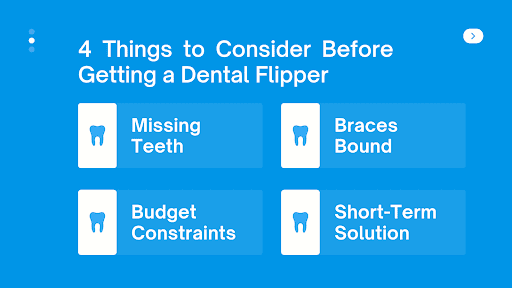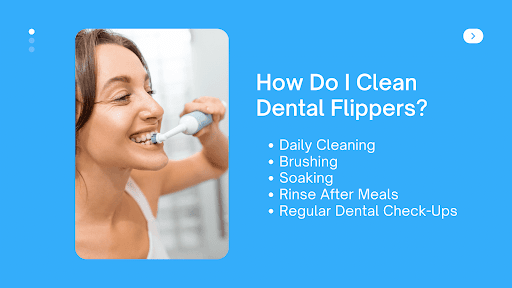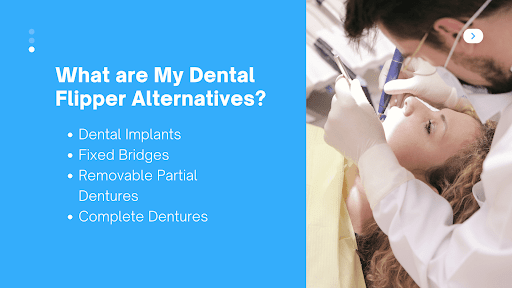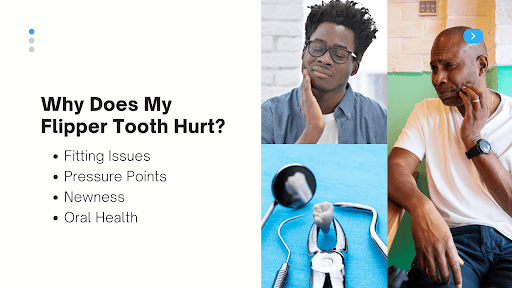When you hear “flipper tooth,” you might think of a dolphin’s shiny grin.
But hold on, we’re talking about something way different.
A flipper tooth, also known as a flipper partial denture, is a temporary prosthetic tooth replacement. It helps fill the gap while you wait for a more permanent solution.
Key Takeaways
- A flipper tooth acts as a temporary tooth replacement until you schedule a permanent orthodontic solution.
- Flipper teeth come in various styles to meet different orthodontic needs.
- Dental flippers are an attractive prosthetic tooth option for those who care about their dental aesthetic.
What is a Flipper Tooth?
A flipper tooth is like a temporary stand-in for a missing tooth. Think of it as a backup singer filling in for the lead while they’re away.
Dental flippers are prosthetic teeth you can pop into your mouth to fill a gap. They’re usually made of acrylic and are held in place by clasping onto the teeth next to the empty space.
While they’re not a permanent fix, dental flipper teeth give you a complete smile as you wait for a more long-term solution.
The 2 Types of Flipper Teeth

Just like shoes, flipper teeth come in different styles for different occasions:
- Single-Tooth Flippers: They are tailor-made for patients with just missing one tooth, filling in that one gap in your smile. Flippers are only suitable for 1-2 missing teeth, not a full arch.
- Partial Flippers: If you are missing a few teeth in a row, partial flippers cover all those missing spots.
Do I Need a Flipper Tooth?

Here’s a list of patients who might find flippers to be just what the orthodontist ordered:
- Missing Teeth: Flippers can be your go-to if you’ve lost a tooth (or a couple) and you’re waiting for a more permanent solution like an implant.
- Braces Bound: Sometimes, before getting braces, a dentist might need to remove a tooth to make space. While waiting for the braces magic to happen, a flipper can help fill in the blank spot.
- Budget Buddies: Dental treatments can be pricey. If you’re looking for a more affordable solution while saving for something permanent, flipper teeth may be a sound pick.
- Short-Term Smilers: If you need a quick fix for a special event, like a school photo or a family gathering, dental flippers can come to the rescue, ensuring you have a picture-perfect smile.
- Healing Heroes: After some dental procedures, your gums and mouth need time to heal before getting a permanent replacement. Flippers can be a comfortable placeholder during this time.
The 6 Benefits of Flipper Teeth
Alright, let’s dive into the fantastic perks of having flipper teeth!
- Say Cheese!: Your smile looks complete again with a flipper tooth. No more hiding your grin in photos or when you laugh!
- Chow Down: While they might not be as strong as natural teeth, flipper teeth give you a boost when it’s time to eat. That means you can enjoy more of your favorite snacks.
- Easy Peasy: Dental flippers are simple to pop in and out. That’s why cleaning them or giving your gums a little break is a breeze.
- Wallet-Friendly: Dental work can sometimes cost a pretty penny. Fortunately, flipper teeth are kinder to your bank account than other options.
- Comfort Zone: With time, most people find flipper teeth comfortable to wear. It’s like they’ve been a part of their mouth forever!
Dental Flipper Drawbacks
While flipper teeth have some worthy advantages, they’ve got their quirks, too:
- Not Superman Strong: Flipper teeth aren’t the strongest compared to other dental options. So, biting into that crunchy carrot might not be the best idea.
- Short-Term Squad: They’re usually a temporary solution. They’re great while you wait for a permanent fix.
- Cleaning Time: Because they’re removable, you’ve got to take them out and clean them regularly. And trust us, you don’t want to slack off on that chore!
- Gum Talks: Your flipper denture might irritate your gums over time.
- Food Traps: Tiny bits of food can sometimes get caught underneath your flipper, which might be a hassle to deal with during classes or meetings.
- Speech Bubbles: Some patients initially find it tricky to talk clearly with flipper teeth. But with some practice, you’ll get the hang of it.
FAQ About Flipper Dentures
How Long Will I Wear My Dental Flipper?
Dental flippers are a temporary solution for a more permanent dental treatment, like a dental implant or a bridge. The length of your treatment can vary. For some, it might be just a few weeks or months. For others, it could be a bit longer, up to a year, especially if they’re waiting for a dental procedure that takes more time.
Can I Eat With a Flipper Tooth?
Absolutely, you can eat with a flipper tooth! However, while you can eat with it, caution about what you munch on is imperative.
It’s best to avoid super hard, sticky, or crunchy foods. Things like candy, nuts, and even crunchy veggies can be challenging for your flipper tooth.
Take smaller bites and chew gently, especially at first. You’ll get the hang of it! And, if you need clarification on something, it doesn’t hurt to cut your food into smaller pieces or skip it for the time being.
Do I Sleep With a Dental Flipper in My Mouth?
Most of the time, dentists recommend taking your dental flipper out before you hit the hay. When you’re sleeping, your flipper tooth needs a break, too!
Taking your dental flipper out gives your gums and the roof of your mouth some time to breathe. Plus, it’s an excellent chance to clean and keep your flipper fresh.
How Do I Clean Dental Flippers?

Cleaning your dental flipper is essential to keep it looking good and fitting comfortably in your mouth:
- Daily Cleaning: Give your flipper a good rinse with lukewarm water daily to eliminate plaque and food particles.
- Brushing: Use a soft-bristled toothbrush to gently scrub your flipper. Don’t use regular toothpaste, as it might be too abrasive. Instead, go for a mild soap or a special denture cleaner.
- Soaking: When you take your flipper out at night, let it chill in a denture cleaning solution or plain water to keep it moist and fresh.
- Rinse After Meals: If you can, give your flipper a quick rinse after eating.
- Regular Dental Check-Ups: Even with all this cleaning, it’s wise to let your orthodontist check your flipper occasionally. They can clean it professionally and ensure everything’s in tip-top shape!
How Should I Store My Flipper Tooth Overnight?
- Grab a Container: Find yourself a denture or flipper case. This little container is made just for storing things like your flipper. It’s the perfect cozy spot for it!
- Fill It Up: Fill your container with lukewarm water or a denture-soaking solution to keep your flipper moist.
- Plop It In: Place your flipper into the filled container. Make sure it’s completely underwater or covered by the solution.
- Seal the Deal: Snap that container lid shut to keep out dust and other things you don’t want on your flipper.
- Keep It Safe: Find a cool, safe spot for your container, like a nightstand or in the bathroom.
What are My Dental Flipper Alternatives?

A dental flipper is just one option when you’re missing a tooth and want to fill that gap:
- Dental Implants: A dental implant is a small screw put into your jawbone, and then a fake tooth is attached on top. They’re strong and can last a long time.
- Fixed Bridges: Think of a bridge in your town that connects two places. In the same way, a dental bridge fills the gap between two teeth. Your natural teeth anchor it on either side of the missing spot.
- Removable Partial Dentures: Unlike a flipper, removable partial dentures are sturdier and have clasps that grip onto your natural teeth.
- Complete Dentures: They replace all the teeth in one go.
Each option has pros and cons, and what’s best for you depends on how many teeth you’re missing and your orthodontist’s opinion.
How Much Do Flipper Teeth Typically Cost?
Flipper teeth are one of the more budget-friendly options when replacing a missing tooth.
Typically, the cost ranges from $300 to $500 per tooth. The price may vary depending on where you live, dental insurance, which dentist you visit, and the details of your flipper tooth.
Why Does My Flipper Tooth Hurt?

There are a few reasons why your flipper tooth is causing discomfort:
- Fitting Issues: A new flipper tooth might need some adjustments. It can rub against your gums or other teeth and cause soreness if it doesn’t fit perfectly.
- Pressure Points: Your flipper tooth rests on the gums. If there’s too much pressure in one spot, it may make that area tender or painful.
- Novelty: Introducing a flipper tooth in your mouth might initially feel strange. This sensation is sometimes mistaken for pain.
- Oral Health: Dental flippers might amplify the pain caused by an underlying issue, like gum disease or an abscess.
Start Your Orthodontic Journey With Dr. Lee!
Contact Patuxent Orthodontics if orthodontic care is the solution to your dental woes. Whether you want to learn more about the benefits of orthodontic care or have questions about the process, use our live chat or call (240) 802-7217 or message us through our Contact Us page to connect with our friendly staff today and book a complimentary consultation!
Our office, located at 44220 Airport View Dr., Hollywood, MD 20636, proudly serves Maryland’s Patuxent area, as well as the Greater Washington DC area. So, if you’re residing in Hollywood, Wildewood, or Leonardtown and are looking for one of the best orthodontists in Maryland, don’t hesitate to visit our office!
We also invite you to keep up with our blog to get answers to many of the frequently asked questions about maintaining your perfect smile, and follow us on Facebook and Instagram to become a part of our smiling community!
References
- Lee, Dr. Richard. “Endosteal Implants: Material, Cost, and Efficiency.” Loudoun Orthodontics, Loudoun Orthodontics, 8 Aug. 2023, loudounorthodontics.com/endosteal-implants-material-cost-and-efficiency/. Accessed 29 Aug. 2023.











